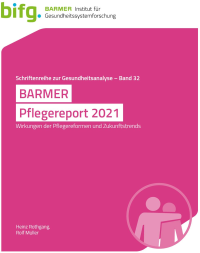
The BARMER Long-Term Care Report was presented today in Berlin. It highlights in particular the effects of the most recent long-term care reforms, and draws conclusions for future developments in the numbers of care dependents, as future staffing and financial requirements are derived from the number and composition of people in need of care. By 2025 and in subsequent years the number of people in need of care will actually be around 1 million more than predicted using conventional analytical methods. The Report discusses current long-term care policy in terms of the issue of personnel requirements – especially in the light of scientific assessments on staffing needs in full-time institutional care facilities. The authors, Professor Dr. Heinz Rothgang and Dr. Rolf Müller, also provide more in-depth studies on case numbers, incidences, prevalences and care processes. The main data sources are the long-term care statistics of the German Federal Statistical Office and routine claims data provided by BARMER.
Sharp growth in numbers (oder: the number of LTC dependents)
The successive inclusion of cognitive impairments in entitlement claims for long-term care insurance benefits means that the number of beneficiaries has progressively increased since the 2010s. According to long-term care figures for 2017-2019, the number of people in need of long-term care grew by 713,000. This growth can be attributed to demographic developments in 145,000 of cases, and other effects in connection with the introduction of care grades in 568,000 cases. Projections for future growth were hitherto based on the extrapolation from current prevalences. Calculations of this kind have invariably unterestimated future figures for care dependents. Current projections, based on care prevalence figures for 2019, underestimated the number of care dependents for the year 2020 by over 6 per cent. The authors of the Long-Term Care Report anticipate that in the coming years there will be no further expansion of entitled beneficiaries by legislative means, but that the effect of the introduction of previous reforms will only gradually abate by 2025. From then on, there will be a total of around 1,000,000 more people in care of need than predicted by conventional estimates. More recent estimates point especially to more care-dependents with Care Grades 1-3, and more people in receipt of care allowances.
Demand for careworkers predicted to be three per cent higher than conventional estimates
In spite of the large number of care-dependents with low care grades, there will also be higher take-up rates in residential care than forecast by conventional means. The new figures reveal that three per cent more care workers will be needed than previously estimated. Altogether, for the year 2030, 510,000 long-term care specialists, 196,000 care assistants with a 1-2 year training programme, and 386,000 untrained care assistants will be required. That is 81,000, 87,000 and 14,000 more, respectively, than indicated for 2019 according to the long-term care statistics. In 2030, therefore, there 182,000 more care workers will be required than in 2019. One should note, however, that even today the current legal requirements for care workers in full-time residential facilities, as well as the proportionate numbers in outpatient and day-care facilities, are often inadequate.
Benefit payments in 2030 comparable to 59m. Euros at today’s prices
In the model calculation, assuming that prevalences remain constant, benefit payments (at today’s prices) will increase to 53 bn. euros by 2030 and to 70.6 bn. euros by 2050. However, as the assumption of a constant prevalence at the level of 2019 has already been disproved for the year 2020, it must be assumed that the introductory effects will level off. Under these conditions, benefit payments (at today’s prices) can be expected to grow to 59 bn. euros by 2030 and 77.4 bn. euros by 2050. These new predictions thus show a financial shortfall of a further 6 bn. Euros as early as 2030.
Training Offensive is needed
The main problem remains the recruitment of care personnel. The main challenge of care policy is to meet increased requirements. To this end, more training opportunities must be made available. Moreover, the profession must be made more attractive by offering improved working conditions and higher pay. In this way it might be possible to persuade carers to remain in employment as carers) and to gain more prospective trainees.
Download (all in German only):
BARMER Pflegereport 2021
Statement von Prof. Rothgang anlässlich der Pressekonferenz
Folienvortrag von Prof. Rothgang anlässlich der Pressekonferenz
Contact:
Prof. Dr. Heinz Rothgang
SOCIUM Research Center on Inequality and Social Policy
Mary-Somerville-Straße 3
28359 Bremen
Phone: +49 421 218-58557
E-Mail: rothgang@uni-bremen.de
Dr. rer. pol. Rolf Müller
SOCIUM Research Center on Inequality and Social Policy
Mary-Somerville-Straße 3
28359 Bremen
Phone: +49 421 218-58554
E-Mail: rmint@uni-bremen.de











